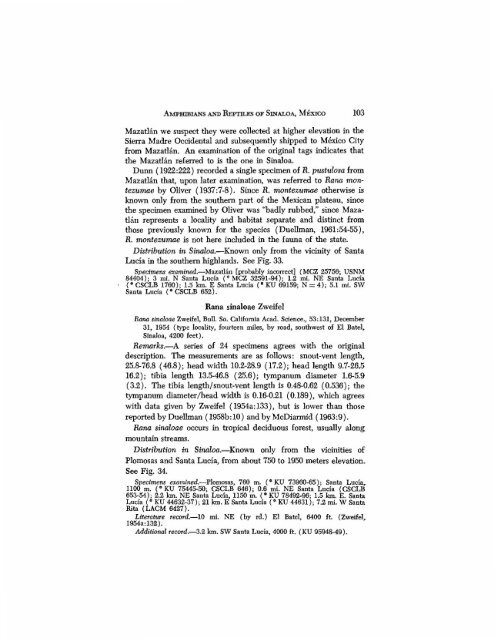The Amphibians and Reptiles of Sinaloa, Mexico - Smithsonian ...
The Amphibians and Reptiles of Sinaloa, Mexico - Smithsonian ...
The Amphibians and Reptiles of Sinaloa, Mexico - Smithsonian ...
Create successful ePaper yourself
Turn your PDF publications into a flip-book with our unique Google optimized e-Paper software.
AMPHIBIANS AND REPTILES OF SINALOA, MEXICO 103<br />
Mazatlan we suspect they were collected at higher elevation in the<br />
Sierra Madre Occidental <strong>and</strong> subsequently shipped to <strong>Mexico</strong> City<br />
from Mazatlan. An examination <strong>of</strong> the original tags indicates that<br />
the Mazatlan referred to is the one in <strong>Sinaloa</strong>.<br />
Dunn (1922:222) recorded a single specimen <strong>of</strong> R. pustulosa from<br />
Mazatlan that, upon later examination, was referred to Rana montezumae<br />
by Oliver (1937:7-8). Since fl. montezumae otherwise is<br />
known only from the southern part <strong>of</strong> the Mexican plateau, since<br />
the specimen examined by Oliver was "badly rubbed," since Mazatlan<br />
represents a locality <strong>and</strong> habitat separate <strong>and</strong> distinct from<br />
those previously known for the species (Duellman, 1961:54-55),<br />
R. montezumae is not here included in the fauna <strong>of</strong> the state.<br />
Distribution in <strong>Sinaloa</strong>.—Known only from the vicinity <strong>of</strong> Santa<br />
Lucia in the southern highl<strong>and</strong>s. See Fig. 33.<br />
Specimens examined.—Mazatlan [probably incorrect] {MCZ 25756; USNM<br />
84404); 3 mi. N Santa Lucia ("MCZ 32591-94); 1.2 mi. NE Santa Lucia<br />
('CSCLB 1760); 1.5 km. E Santa Lucia (*KU 69159; N = 4); 5.1 mi. SW<br />
Santa Lucia (* CSCLB 652).<br />
Rana sinaloae Zweifel<br />
Rana sinaloae Zweifel, Bui], So. California Acad. Science,, 53:131, December<br />
31, 1954 (type locality, fourteen miles, by road, southwest <strong>of</strong> El Bate!,<br />
<strong>Sinaloa</strong>, 4200 feet).<br />
Remarks.—A series <strong>of</strong> 24 specimens agrees with the original<br />
description. <strong>The</strong> measurements are as follows: snout-vent length,<br />
25.8-76.8 (46.8); head width 10.2-28.9 (17.2); head length 9.7-26.5<br />
16.2); tibia length 13.5-46.8 (25.6); tympanum diameter 1.6-5.9<br />
(3.2). <strong>The</strong> tibia length/snout-vent length is 0.48-0.62 (0.536); the<br />
tympanum diameter/head width is 0.16-0.21 (0.189), which agrees<br />
with data given by Zweifel (1954a: 133), but is lower than those<br />
reported by Duelhnan (1958b: 10) <strong>and</strong> by McDiarmid (1963:9).<br />
Rana sinaloae occurs in tropical deciduous forest, usually along<br />
mountain streams.<br />
Distribution in <strong>Sinaloa</strong>.—Known only from the vicinities <strong>of</strong><br />
Plomosas <strong>and</strong> Santa Lucia, from about 750 to 1950 meters elevation.<br />
See Fig. 34.<br />
Specimens examined.—Flomosas, 760 m. (° KU 73960-65); Santa Lucia<br />
1100 m. ("KU 75445-50; CSCLB 646); 0.6 mi. NE Santa Lucia (CSCLB<br />
653-54); 2.2 km. NE Santa Lucia, 1150 m. (*KU 78492-96: 1.5 km. E. Santa<br />
Lucia (° KU 44632-37); 21 km. E Santa Lucia (* KU 44631 ; 7.2 mi. W Santa<br />
Rita (LACM 6427).<br />
Literature record.—10 mi. NE (by rd.) El Batel, 6400 ft. (Zweifel,<br />
1954a: 132).<br />
Additional record.—3.2 km. SW Santa Lucia, 4000 ft. (KU 95948-49).
















